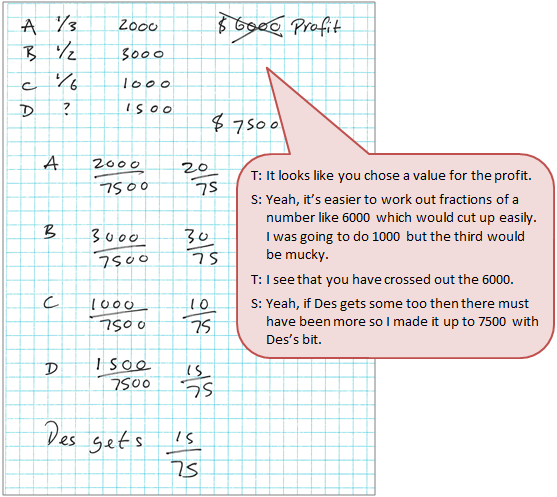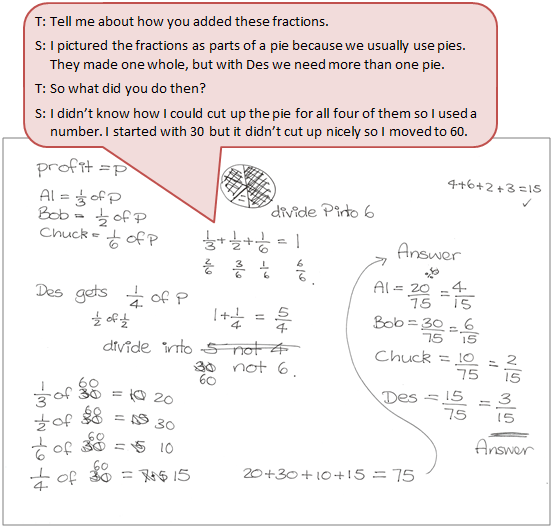The purpose of this activity is to engage students in solving a problem involving fractions and proportional reasoning.
This activity assumes the students have experience in the following areas:
- Representing fractions in different ways, including diagrams.
- Finding fractions of amounts.
- Adding fractions.
- Solving word problems with fractions.
The problem is sufficiently open ended to allow the students freedom of choice in their approach. It may be scaffolded with guidance that leads to a solution, and/or the students might be given the opportunity to solve the problem independently.
The example responses at the end of the resource give an indication of the kind of response to expect from students who approach the problem in particular ways.
 Three men run a business together.
Three men run a business together.
The proportion of the profit they each get at the end of the month is based on the proportion of the funds they have invested in the business.
The April profit is shared out so that Al gets one third, Bob gets one half and Chuck gets one sixth.
In May, Des joins the group, investing half as much as Bob invested.
What share of the profit can Des expect to get?
The following prompts illustrate how this activity can be structured around the phases of the Mathematics Investigation Cycle.
Make sense
Introduce the problem. Allow students time to read it and discuss in pairs or small groups.
- Do I understand the situation and the words? (Students may not be familiar with the word proportion which means fraction relationships are involved.)
- What do you know and what don’t you know? (The total amount invested by Al, Bob and Chuck at the start is not known. Students need to deal with this lack of closure.)
- What will my solution look like? (The solution will be the fraction of profit each person gets after Carl joins the business. The answer must be supported with evidence.)
Plan approach
Discuss ideas about how to solve the problem. Emphasise that, in the planning phase, you want students to say how they would solve the problem, not to actually solve it.
- Where will I start? What do I need to do first?
- What strategies can I use to get started? (Diagrams, particularly length models are useful. Fraction notation is needed to represent the amounts.)
- Do I have a sense of the fractions of profit that each person will get after Des joins the company? Will the fractions for Al, Bob, and Chuck be more or less than before?
- Could I choose a sensible amount used to start up the company? Why would using that number be useful? How will the total amount change when Des joins the company?
- What tools will I use?
Take action
Allow students time to work through their strategy and find a solution to the problem.
- Am I recording my workings in a systematic way so others could follow them?
- Is my strategy working or do I need to change tack?
- How can we share the mahi in our group to get the best result?
- Does my answer seem correct? Do the fractions for all four people add to one? What does the whole (one) represent in this problem? (After Des joins a new one that is 1 ¼ of the previous amount invested is needed.)
- Is there another possible answer or way to solve it? Can I be more efficient?
Convince yourself and others
Allow students time to check their answers and then either have them pair share with other groups or ask for volunteers to share their solution with the class.
- What is the solution? Can I show that the solution is correct? How?
- Is my working clear for someone else to follow?
- How would I convince someone else I am correct?
- Could I have solved the problem in a more efficient way?
- Have I considered all the information?
- What connections can I see to other situations, why would this be?
- Which ideas or tools worked well in my investigation?
- What could I try differently next time?
Examples of work
Work sample 1
The student chooses a fixed amount that is invested at the start of the business and divides that amount among Al, Bob, and Chuck according to the fractions given. They allocated Des half or Bob’s amount to get a new total and works out the fractions of the new total for each person.
Click on the image to enlarge it. Click again to close.
Work sample 2
The student works abstractly with fractions to determine that the new whole is 1 ¼ of the former amount when Des joins the business. They then assign an amount of profit and use the fractions to establish each person’s share of the profit.

